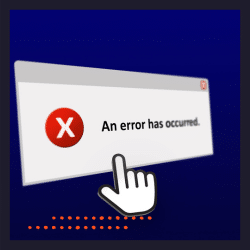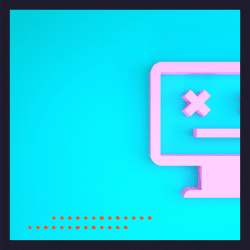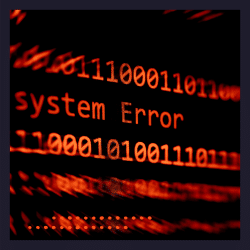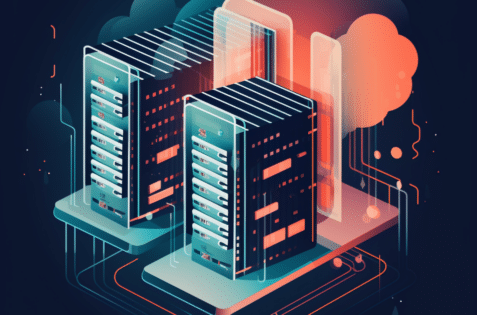Introduction

Maintaining optimal website uptime is essential today. A website’s performance directly impacts user experience, influencing the audience’s perception of a brand and playing a pivotal role in customer acquisition and retention.
Downtime or errors on a website can lead to adverse outcomes, like loss of revenue and user trust.
One standard error encountered in WordPress, a popular content management system, is the ‘There Has Been a Critical Error on Your Website.’ This error can be particularly disruptive, interrupting the smooth operation of your website and potentially causing significant inconvenience for your users.
In the ensuing sections, we will delve into the causes of this error and how to tackle it effectively, ensuring your website remains a reliable digital platform.
Understanding the ‘WordPress There Has Been a Critical Error on This Website’ Message

A “Critical Error” in a WordPress site typically implies that your website has encountered an unexpected situation that prevents it from functioning normally.
Recognizing the ‘Critical Error’ Message

Usually, as an administrator, you become aware of the ‘Critical Error’ in one of several ways.
You may receive an email notification in your site admin inbox detailing the error, or you might personally encounter the error message displayed prominently on your screen when you attempt to access your website.
The White Screen of Death
In some instances, you might be greeted with the dreaded ‘White Screen of Death,’ a symptom of a critical error where your website’s screen turns completely blank, indicating a severe issue requiring immediate attention.
Any of these scenarios indicate the presence of a ‘Critical Error’ that demands prompt rectification.
The Problem is Server-Side

It’s crucial to note that the ‘There Has Been a Critical Error on Your Website’ message in a WordPress site indicates a server-side problem, not a browser issue.
This implies that the error arises from issues on the server where your website is hosted rather than issues with the user’s browser or device.
A server error might be caused by various factors, including a problem with a plugin or theme, a PHP error, or issues with your site’s database.
There are Many Possibilities
Plugin Conflict
Firstly, it might be due to a plugin or theme conflict. WordPress websites often use various plugins and themes, which may occasionally be incompatible with each other or with specific versions of WordPress itself.
Memory Limit
Secondly, the error can be caused by memory limit exhaustion, where your website uses all the available memory allocated by your hosting provider.
Bad or Incompatible PHP Code
Lastly, the problem can stem from errors in the website’s code within WordPress, a plugin, or a theme. Incompatible code is when the PHP version a plugin or theme was written to is not the same as what is installed on the same web host or server. Bad code fails normal PHP code execution and is a true “bug.”
The Importance of Your Site Admin Email Inbox in Critical Situations

WordPress has an effective mechanism to alert you as the website administrator about critical errors occurring on your website. Whenever a critical error arises, WordPress automatically sends an email notification to the site admin email address.
This email typically contains the details of the error, including information about what part of your website caused the error and the actions you can take to rectify it.
Setting Up and Updating the Admin Email

To receive these vital notifications, it is crucial to ensure that you have an admin email set up and that it is up-to-date.
You can set or change this email address in the WordPress dashboard by navigating to ‘Settings’ and then ‘General.’ Here, you will find a field labeled ‘Email Address’ where you can input your preferred admin email.
Remember to keep this information updated, as WordPress will use this email address to send notifications about updates, password changes, and, most importantly, critical errors.
Interpreting Notifications
Reading and interpreting these error notifications can initially seem daunting, especially if you’re unfamiliar with PHP or coding.
However, these notifications are designed to be user-friendly and provide the necessary information. The email will generally include the error type, the plugin or theme that caused the error, and the file and line number where the error was detected.
This information can be invaluable when troubleshooting and resolving the error and helpful when seeking assistance from a web developer or support forums. Be sure to keep all these in mind to ensure the smooth running of your WordPress website.
The Urgency of Taking Immediate Action to Minimize Site Downtime

When your website encounters a critical error, it is important to act swiftly to minimize site downtime. Prolonged periods of inaccessibility can have several detrimental consequences for your website and business.
Site downtime can negatively impact your SEO ranking as search engines prioritize websites with consistent uptime. Additionally, it can lead to loss of revenue, especially for e-commerce websites where every minute of downtime could equate to missed sales.
Frequent or prolonged downtime can erode user trust, affecting your brand’s reputation and customer loyalty. Therefore, the moment a critical error is detected, immediate action should be taken to identify the cause of the error and implement corrective measures.
This swift response can help reduce the duration of downtime, thus mitigating its impact on your website’s performance and your business’s bottom line.
Implementing Safeguards: Backups and Maintenance Mode

The Significance of Regular Backups

Ensuring that all your content and data are safe when dealing with critical errors on your website is crucial.
Regular backups are a safety net, allowing you to restore your website to a previous, error-free state if necessary. WordPress offers a variety of plugins that can automate the backup process, such as UpdraftPlus, BackWPup, and VaultPress.
These plugins enable you to schedule automatic backups, ensuring that you always have a recent backup to fall back on. In addition to using plugins, it is advisable to employ the backup services offered by your hosting provider.
This dual approach to backups provides an extra layer of data protection.
Activating Maintenance Mode During Error Resolution
While you are troubleshooting and resolving the critical error, activating the ‘Maintenance Mode’ on your website is beneficial. This mode lets you display a user-friendly message to your visitors, informing them that your website is temporarily unavailable due to maintenance.
This transparency can help preserve your brand image, assuring users that you are actively working to resolve the issue. Several WordPress plugins, such as WP Maintenance Mode or SeedProd, can assist in setting this up.
These plugins allow you to customize the maintenance mode page, ensuring it aligns with your brand identity and communicates the necessary information to your visitors.
Implementing regular backups and engaging Maintenance Mode during critical situations can protect your data, uphold your brand image, and ensure a swift recovery from website disruptions.
Diagnosing the Issue Behind the Critical Error Message

Accessing Your Website’s Error Logs

An error log file is valuable for troubleshooting your website’s critical errors. These logs contain detailed records of all incidents on your website, providing insights into the causes and effects of each error.
To access these logs, navigate to your website’s file manager, typically found through your hosting provider’s control panel.
Look for the ‘public_html’ folder in the file manager and find ‘wp-content.’ Here, you should see a file named ‘debug.log’.
By examining this file, you can identify the most recent errors on your website, assisting in pinpointing the issue.
Identifying and Managing Problematic Plugins and Themes
One of the most common sources of conflicts on a WordPress website is plugins or themes incompatible with one another or the WordPress core itself.
To determine if a plugin or theme is causing a conflict, you must first deactivate all your plugins and switch to a standard WordPress theme. This step will help identify whether the issue lies with one of the plugins or themes that were previously active. If the error is resolved after doing this, you can confirm that the issue originated from a plugin or theme.
To identify the exact plugin or theme causing the conflict, reactivate each plugin individually, checking your website for the error after each activation. If the error reappears after activating a specific plugin, you’ve found the culprit.
The same method applies to themes. Once the problematic plugin or theme is identified, you can either look for an update, contact the developer for a fix, or find an alternative.
Regular maintenance and prompt attention to errors or conflicts are key to managing a stable WordPress website. Regularly checking your error logs and keeping your plugins and themes up-to-date can prevent many common issues and keep your website running smoothly.
The Role of the PHP Memory Limit in Triggering the Error

The PHP script memory limit is a restriction set to prevent scripts from consuming all available memory on your server. In essence, PHP scripts can use the maximum amount of memory.
If a script exceeds this limit, it results in a PHP fatal error, which could be the cause of the critical error in WordPress.
Checking the Current Memory Limit

You can use the ‘phpinfo()’ function to check your PHP memory limit.
- Create a new file in your website’s root directory, name it something like ‘phpinfo.php’, and add the following line: `<?php phpinfo(); ?>`.
- Then, navigate to ‘yourwebsite.com/phpinfo.php’ in a web browser. The resultant page will display your PHP configuration, including your memory limit.
How to Increase the Memory Limit
To prevent future errors, you may consider increasing your PHP memory limit. There are several ways to do this:
- Editing Your ‘wp-config.php’ File: Locate the ‘wp-config.php’ file in the root of your WordPress installation and add the following line: `define(‘WP_MEMORY_LIMIT’, ‘256M’);`. This line sets the PHP memory limit to 256MB.
- Editing Your ‘.htaccess’ File: In your ‘.htaccess’ file, add the following line: `php_value memory_limit 256M;`.
- Editing Your ‘php.ini’ File: If you can access your ‘php.ini’ file, find the line that reads `memory_limit =` and increase the value, e.g., `memory_limit = 256M;`.
Remember to replace ‘256M’ with the desired limit. After making these changes, recheck your PHP memory limit to ensure the new limit is in effect.
Be cautious when increasing the PHP memory limit; setting it too high can exhaust your web server’s resources. Constantly monitor your website’s performance and adjust accordingly.
Common Solutions to Resolve the Critical Error

Disabling Plugins and Themes to Isolate the Conflict

If you suspect a plugin or theme conflict is causing the critical error in WordPress, disable all plugins and switch to a default WordPress theme.
This process will help you isolate the conflict by showing whether the error is resolved in a default WordPress environment.
If the error disappears with all plugins disabled and a default theme in place, the issue was likely caused by a plugin or theme conflict.
Updating WordPress, Plugins, and Themes
One of the common reasons for a critical error in WordPress is outdated core files, plugins, or themes.
Regularly updating your WordPress installation, including all plugins and themes, can prevent many such issues.
Updates typically include bug fixes and security patches that can resolve issues and protect against future ones. Before updating, remember to take a complete backup in case something goes wrong.
Contacting Your Hosting Provider for Server-Side Issues
If the error persists despite trying all the above solutions, the issue may reside on the server side.
Your hosting provider’s support team can help troubleshoot and resolve server-related issues. They can check for server downtime, memory issues, or configuration errors that may be causing the critical error in WordPress.
Checking and Resolving Issues in the .htaccess File
The .htaccess file is another common source of issues on WordPress websites.
An incorrect rule in this file can bring your entire site down. To see if this is the case, try renaming your .htaccess file (to something like .htaccess_old) and see if the error persists. If it does, the issue was not with your .htaccess file.
If the site starts working, you know the problem was in the .htaccess file. You can then regenerate a new .htaccess file by visiting your WordPress admin area’s ‘Permalinks’ settings page.
Advanced Troubleshooting: When the Common Fixes Don’t Work

Advanced troubleshooting techniques are often necessary if the common fixes don’t remedy the critical error. These methods require a deeper understanding of WordPress and its underlying technologies.
Debugging in WordPress

WordPress has specific debugging systems designed to simplify finding and understanding coding errors.
By enabling WP_DEBUG, a feature in the wp-config.php file, you can trigger the display of PHP errors, notices, and warnings.
This feature is invaluable in identifying the specific script or function causing problems. However, displaying these details on a live website can pose a security risk, so this method is best for quick diagnosis or done on a staging environment.
Manual Theme or Plugin Update
If you cannot access your WordPress dashboard due to a critical error, you might need to update your themes or plugins using an FTP it manually.
While this method is more complex, it’s often necessary when the error precludes standard updating methods. Always back up your website before manually updating it to avoid data loss.
Checking for Corrupt WordPress Core Files and Considering a Fresh Installation
Corrupt WordPress core files can also trigger critical errors. You can check for this by replacing the wp-admin and wp-includes folders with fresh copies from a WordPress download.
If you continue encountering critical errors, a fresh installation of WordPress might be necessary. Remember to backup your website before proceeding with a new installation.
Contact a WordPress Developer
Sometimes, resolving a complex issue requires professional help. If you cannot rectify or fix the critical error, consider contacting a WordPress developer or a professional WordPress support service. These experts have the tools and expertise to diagnose and troubleshoot complex WordPress issues.
Seeking Help from Developer Forums and Communities
If these advanced troubleshooting steps don’t resolve the critical error, you can seek help from developer forums and communities.
Websites such as WordPress.org Support, Stack Overflow, and WPBeginner have dedicated forums where you can post your issue and get help from WordPress experts worldwide.
Be sure to provide as much information as possible about the error and what you’ve done to resolve it, as this can help others diagnose and solve your problem.
Prevention: Best Practices to Avoid Future Critical Errors

Regularly Updating WordPress, Themes, and Plugins
Maintaining the most recent versions of WordPress, your website themes, and plugins is crucial in preventing critical errors.
Updates come with new features and often include fixes for bugs and vulnerabilities that could otherwise lead to serious issues. Make sure to keep your WordPress core, themes, and plugins regularly updated to ensure the smooth running of your website.
Opting for Reliable Hosting Services

Choosing a reliable web hosting service is crucial for your WordPress website’s overall performance and stability. Select a hosting provider known for its excellent uptime, robust security features, and responsive customer service. This can help you avoid server-side issues that could lead to critical errors.
Conducting Periodic Website Performance Checks
Regularly conducting performance checks on your website is a preventative measure to help you avoid future critical errors.
These checks can help you identify and rectify issues such as slow page load times, broken links, or any other elements that might negatively impact your website’s performance. Numerous tools are available online, both free and paid, which can assist you in performing these checks.
Ensuring a Robust Backup Strategy is in Place
A robust backup strategy is essential for safeguarding your website data. Regular backups protect you from data loss in a critical error or cyber attack.
Backups allow you to restore your website to a working state without losing content. You can automate the backup process using plugins or opt for a hosting service that includes regular backups as part of their package.
Conclusion

In conclusion, promptly addressing critical errors is essential in maintaining your WordPress website’s performance, security, and overall user experience.
These issues, if left unaddressed, could have significant impacts, such as loss of data, dropping SEO rankings, and potential security vulnerabilities.
Emphasis must be placed on prevention through regular site maintenance, including updates of WordPress core, themes, and plugins.
Additionally, opting for a reliable hosting service and performing periodic website performance checks can aid in the early detection and prevention of potential issues.
Staying informed about the latest WordPress updates and having a robust backup strategy is vital in safeguarding your website from critical errors.
Through these practices, you can ensure your WordPress site’s smooth, efficient, and secure operation.








